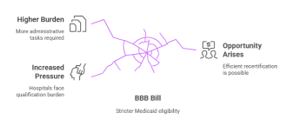
At Resource Corporation of America, we’ve spent more than 30 years standing at the intersection of patients, hospitals, and public policy. Since our first year in 1994, one truth has never shifted: undocumented immigrants often find themselves outside the circle of Medicaid’s full promise. And yet, while the exclusion has always been there, the way it’s been enforced, and the options left to hospitals and states have transformed.
1994: RCA’s First Year, A Baseline of Exclusion
When RCA opened its doors, federal Medicaid rules drew a sharp line: undocumented immigrants were not eligible for full Medicaid, except in true emergencies. A pregnant woman in crisis, a trauma victim, those cases were reimbursable. Everything else was shut out.
There was a gray zone called PRUCOL (Permanently Residing Under Color of Law), but for most hospitals, it was paperwork in a locked cabinet, rarely applied, rarely useful. States that wanted to do more could dig into their own coffers, and some did, funding prenatal care or child coverage. But no federal match followed them. The system left hospitals holding the bag, and RCA learned early how critical it was to uncover every pathway of coverage, no matter how small.
1996: The Walls Go Higher
Two years later, PRWORA (Personal Responsibility and Work Opportunity Reconciliation Act) slammed the door tighter. “Qualified” immigrants were defined; everyone else was excluded. Even lawful residents had to wait five years. For the undocumented, it meant the only lifeline remained emergency Medicaid, and the administrative tone grew harder. RCA adapted, helping hospitals navigate these shifting definitions, but the baseline stayed: exclusion first, exceptions rare.
2025: The BBB Bill and a Hardened Landscape
Fast forward to today. The new Better Benefits and Barriers (BBB) bill reaffirms the exclusion with clear definitions for every State to follow.
- Eligibility redrawn: Medicaid (and Medicare) now explicitly limited to citizens and lawful permanent residents, period.
- Annual audits: Agencies must actively review enrollees and terminate those who no longer meet the tightened definition.
- Humanitarian carve-outs: Nearly erased, exceptions are fewer than ever.
- State role: States may still use their own money to soften the blow, but federal partnership is formally and finally off the table.
What was once a passive exclusion has become an active.
The New Reality for Hospitals
Undocumented patients will still qualify for emergency services, but more will be arriving at your doors, often needing to reapply with every new admission. Each encounter becomes a restart, requiring careful navigation to avoid these visits from going unfunded. Without the right process, these patients risk slipping through the cracks. That’s why having a strong partner like RCA is critical to put a comprehensive solution in place that helps individuals get recertified quickly and ensures hospitals capture every available dollar of support.
RCA’s Takeaway: Hype or Back to Normal?
From our vantage point, having walked with hospitals since 1994, the throughline is clear: undocumented immigrants have never had full Medicaid. The change in 2025 is not the creation of exclusion but the intensification of it.
- In 1994, exclusion was the baseline.
- In 1996, walls grew higher.
- In 2025, the BBB bill cements those walls in stone and posts guards at the gates.
For hospitals, this means greater pressure on qualification or risk of uncompensated care, and higher administrative burdens. But with the right partner, it also means opportunity: to catch patients before they fall, to recertify them efficiently, and to secure financial relief where others see only dead ends.
The story isn’t hype; it’s a return to form, with fewer cracks of daylight. What’s changed is not the principle of exclusion, but the precision and permanence with which it is enforced.

Leave A Comment
You must be logged in to post a comment.